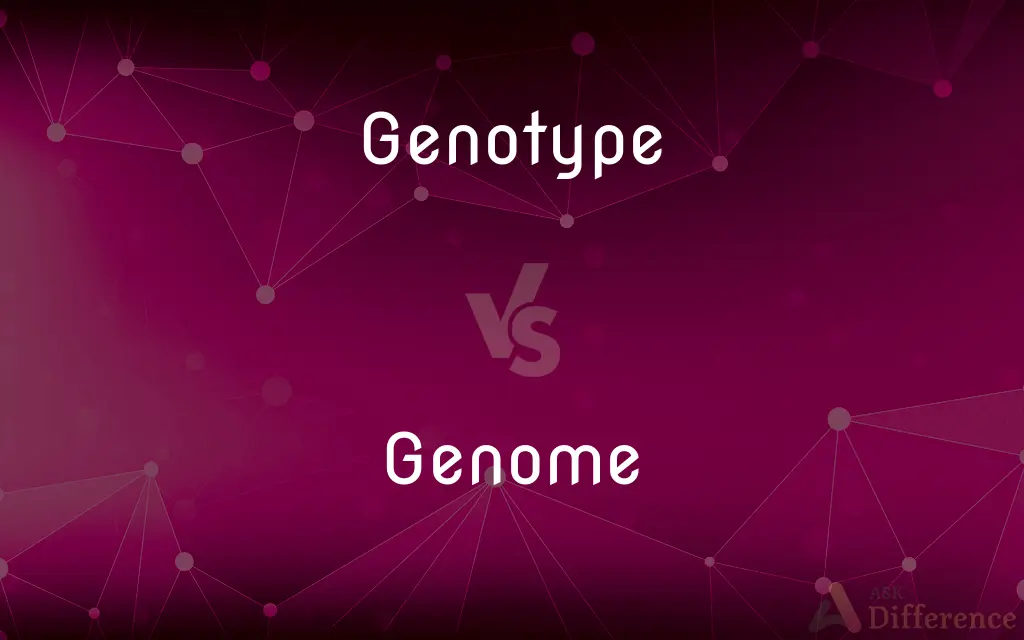Genotype vs. Genome — What's the Difference?
By Maham Liaqat & Urooj Arif — Updated on March 1, 2024
Genotype refers to the specific genetic makeup of an organism, while the genome is the complete set of genetic material present in an organism.

Difference Between Genotype and Genome
Table of Contents
ADVERTISEMENT
Key Differences
The genotype of an organism includes all the genes it possesses, encompassing both expressed and non-expressed genes that contribute to its hereditary traits. This concept is fundamental in genetics, highlighting the role of inheritance in an organism's physical and behavioral characteristics. The genome, on the other hand, is a broader term that refers to the entire collection of DNA in an organism, including all of its genes as well as non-coding sequences.
Genotypes are often discussed in the context of specific traits, such as eye color or disease susceptibility, and how variations in genes influence these traits. The genome encompasses the complete set of instructions necessary for building and maintaining that organism throughout its life. It's a comprehensive map of an organism’s genetic information, providing a holistic view of its potential genetic expression.
The genotype represents the actual set of genes an organism inherits from its parents, the genome includes this information and much more. It's the total genetic context within which specific genes operate. Understanding an organism's genome is crucial for comprehensive genetic research, allowing scientists to study not just individual genes, but also their interactions and the role of non-coding regions in gene expression and regulation.
The relationship between genotype and genome is akin to the difference between a chapter and the entire book. The genotype focuses on specific parts of the genetic material that can influence certain traits, whereas the genome is the entire “book” of genetic information. Both concepts are interrelated, with the genotype being a subset of the larger genome, and each plays a unique role in the study of genetics and heredity.
Comparison Chart
Definition
The specific genetic makeup of an organism, including both expressed and non-expressed genes.
The complete set of DNA in an organism, including all genes and non-coding sequences.
ADVERTISEMENT
Focus
Specific genes and their variations that influence traits.
The entire genetic material of an organism.
Role in Genetics
Determines hereditary traits and susceptibility to certain diseases.
Provides a comprehensive map of an organism's genetic information.
Components
Only genes.
Genes and non-coding DNA sequences.
Importance
Key in understanding inheritance and trait variations.
Essential for comprehensive genetic research and understanding the full genetic potential.
Compare with Definitions
Genotype
The inherited instructions for specific traits.
The genotype dictates whether a dog will have a long or short coat.
Genome
All the genetic material within an organism's chromosomes.
The genome of the fruit fly is a popular model for genetic studies.
Genotype
The specific genetic composition of an individual.
The genotype of the pea plants determined their flower color.
Genome
The complete set of an organism's DNA, including all of its genes.
Sequencing the human genome has revolutionized genetics.
Genotype
The genetic makeup influencing a particular trait.
The genotype for sickle cell anemia involves specific hemoglobin gene variants.
Genome
The basis for genetic engineering and biotechnology.
Scientists manipulate the genome to create genetically modified organisms.
Genotype
A term used in genetic analysis and breeding.
Breeders select for desirable genotypes in crops.
Genome
The full genetic instruction manual for an organism.
The rice plant's genome contains thousands of genes important for growth.
Genotype
A set of alleles that an organism carries.
His genotype includes a recessive allele for blue eyes.
Genome
The total genetic content contained in a haploid set of chromosomes in eukaryotes, in a single chromosome in bacteria or archaea, or in the DNA or RNA of viruses.
Genotype
The genotype of an organism is its complete set of genetic material. However, the term is often used to refer to a single gene or set of genes, such as the genotype for eye color.
Genome
A comprehensive map for genetic research.
The genome project aims to identify all genetic material in a species.
Genotype
The genetic makeup, as distinguished from the physical appearance, of an organism or a group of organisms.
Genome
In the fields of molecular biology and genetics, a genome is all genetic material of an organism. It consists of DNA (or RNA in RNA viruses).
Genotype
The combination of alleles located on homologous chromosomes that determines a specific characteristic or trait.
Genome
An organism's genetic material.
Genotype
A specific combination of alleles at one or more loci on a chromosome.
Genome
(genetics) The complete genetic information (either DNA or, in some viruses, RNA) of an organism.
Genotype
A group of organisms having the same genetic constitution.
Genome
The ordering of genes in a haploid set of chromosomes of a particular organism; the full DNA sequence of an organism;
The human genome contains approximately three billion chemical base pairs
Genotype
The type species of a genus; generitype.
Genotype
The genetic constitution of an organism, specifying the particular alleles at defined loci in the genome; - used with respect to one gene, a specific group of genes, or the entire set of genes within the organism. Contrasted with phenotype.
Genotype
A group of organisms sharing a specific genetic constitution
Common Curiosities
What is the main difference between a genotype and a genome?
The genotype refers to an organism's specific genetic makeup, while the genome is the complete set of genetic material in an organism.
How do genotypes relate to phenotypes?
The genotype contributes to the phenotype, which is the observable characteristics of an organism, but environmental factors also play a role.
Can the genotype change during an organism's life?
The genotype is generally stable, but mutations can occur, altering an organism's genetic makeup.
Why is the genome important for genetic research?
The genome provides a complete picture of an organism's genetic potential, crucial for understanding genetics, disease, and evolution.
How are genotypes and genomes studied?
Genotypes are studied through genetic tests that look at specific genes, while genomes are analyzed through sequencing techniques that read the entire DNA sequence.
Is the genome the same in all cells of an organism?
Yes, with few exceptions (like red blood cells in humans), the genome is consistent across an organism's cells.
Is the human genome fully understood?
While the human genome has been sequenced, the functions of many parts of the genome are still being researched.
What advancements have been made possible by studying the genome?
Genome studies have led to breakthroughs in personalized medicine, understanding evolutionary relationships, and developing GMOs.
Do all organisms have a genome?
Yes, all organisms, from the simplest bacteria to humans, have genomes that contain their genetic information.
Can two individuals have the same genotype?
Identical twins can have nearly identical genotypes, but small mutations can occur. In general, each individual's genotype is unique.
How does the environment influence the genotype and genome?
The environment doesn't change the genome but can influence how certain genotypes are expressed, affecting the phenotype.
How are genetic disorders related to genotypes and genomes?
Genetic disorders can result from specific mutations in an individual's genotype, which are part of the larger genome.
What role does non-coding DNA play in the genome?
Non-coding DNA, once thought to be "junk," plays crucial roles in regulating gene expression and maintaining chromosome structure.
How do genotypes affect an organism's adaptation and evolution?
Variations in genotypes contribute to genetic diversity, affecting an organism's ability to adapt to environmental changes and evolve over time.
What is the significance of mapping the genome of endangered species?
Mapping the genomes of endangered species can aid in conservation efforts by understanding genetic diversity and guiding breeding programs.
Share Your Discovery

Previous Comparison
Final vs. Terminal
Next Comparison
Roist vs. RoastAuthor Spotlight
Written by
Maham LiaqatCo-written by
Urooj ArifUrooj is a skilled content writer at Ask Difference, known for her exceptional ability to simplify complex topics into engaging and informative content. With a passion for research and a flair for clear, concise writing, she consistently delivers articles that resonate with our diverse audience.














































